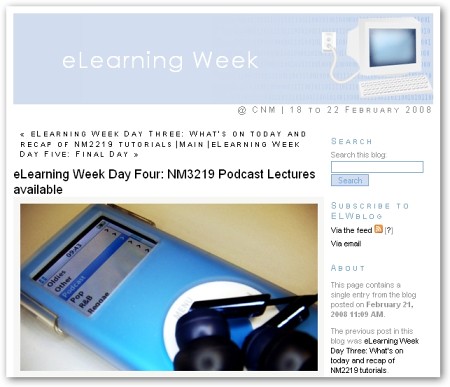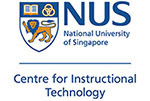
The first eLearning Week (eLW) in NUS took place in late February at the Communications & New Media Programme, with the support of the Office of Safety, Health and Environment.
CIT’s objectives for the week were to prepare, monitor and test the readiness and ability of our students, staff and systems to cope with an emergency situation where on-campus teaching facilities are unavailable.
To those ends, we facilitated various means of conducting lectures and tutorials online. These included:
• Breeze (Online presentations – slides plus audio)
• Centra (Virtual Classroom)
• Comprehensive use of IVLE, particularly the Chat and Forums
• Podcast lecture
• Instant messaging
Overall, the exercise was successful in meeting its objectives. eLW provided CIT with several learning points, the most important of which are highlighted below:
1. Tool to fit the lecturer
It was vital to allow lecturers to choose tools that they were comfortable with. Early training sessions enabled lecturers to match their perceived level of technological competence to the complexity of the various tools.
While this resulted in a number of lecturers opting not to use Centra after expressing initial interest, the situation could arguably have been worse if lecturers felt tied-in to using tools with steep learning curves.
Recommendations: Continue with tool preview sessions for staff before semester begins, closer collaboration with lecturers to determine their needs.
2. Early preparation vital
Regardless of the tools used, early preparation was of paramount importance. This could be seen from the experiences of various lecturers, particularly several who used Breeze. Partly due to the fact that CIT promotes Breeze as a rapid eLearning content creation tool, several lecturers started preparing their Breeze presentations just prior to eLW. A number experienced technical difficulties, which delayed the publication of their respective lectures online.
Recommendations: Those liaising with lecturers have to provide reminders about preparing early regardless of the tool being used.
3. Expectations need to be managed
From the lecturers’ feedback, it is apparent CIT should have managed lecturers’ expectations in a more comprehensive manner.
Recommendations: The following points need to be reinforced – (1) the eLW scenario involving a limited/full campus quarantine, (2) that quality of lessons/communication will most likely be affected, (3) the relative lack of non-verbal cues for most of the tools, (4) the fact that real-life factors will still come into play for online learning (e.g. students can be late for online learning just as they can be for a class on campus), (5) the technology may fail or be problematic for various reasons (which CIT will do its best to resolve if those situations arise).
4. Student Feedback
There is a lack of student feedback that can be analyzed. This is due, in part, to the lack of a proper feedback mechanism and the simplicity of the questions.
Recommendations: Work with the lecturers to find out what kind of feedback they would like to have. Feedback also has to be garnered from students after each lecturer and tutorial. The liaison should work with their respective lecturers to integrate feedback gathering into their lecture/tutorial. This should also be settled early so that it can be worked into various lectures and tutorials.

